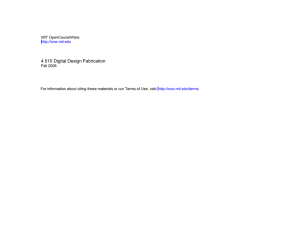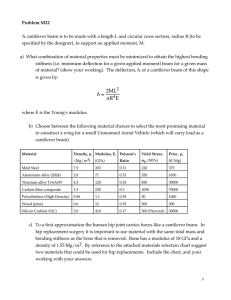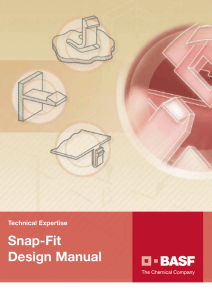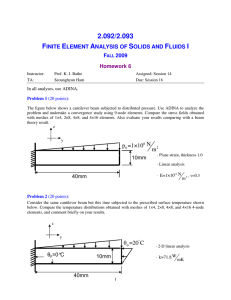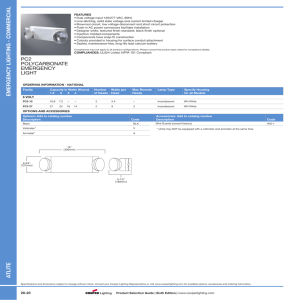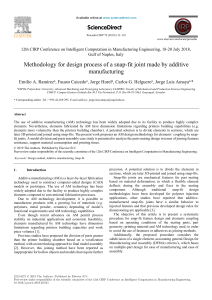Snap-Fit Design
advertisement
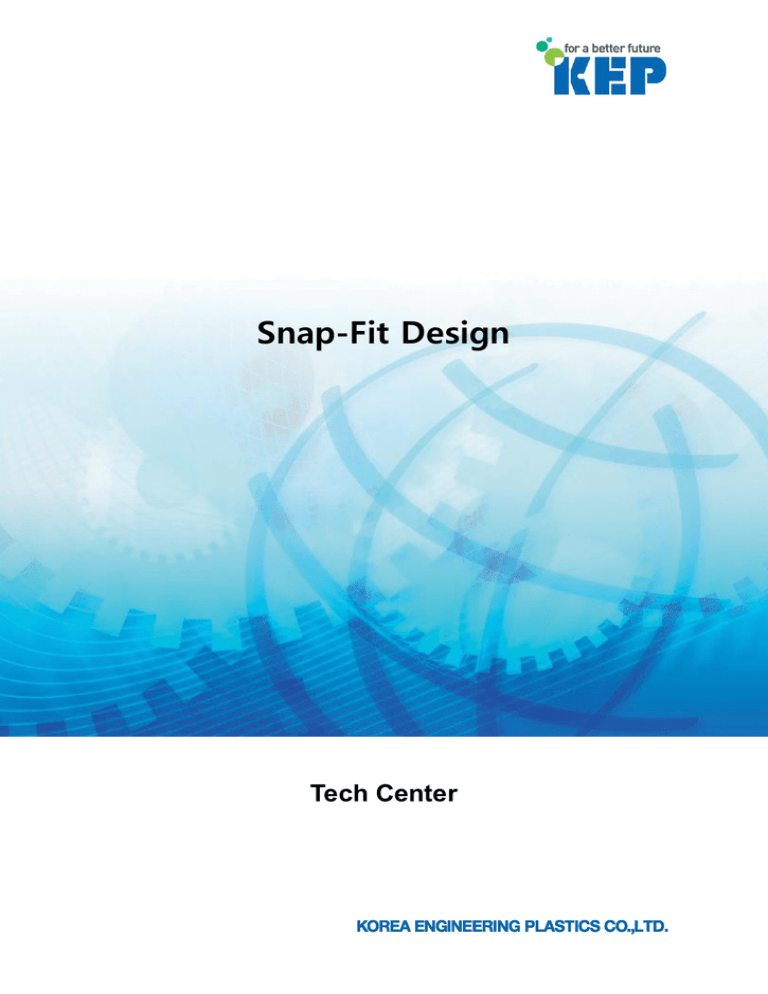
Snap-Fit Design Tech Center www.kepital.com 1. Snap-Fit Fastening [Figure 1] Snap-Fit (1) The Snap-Fit fastening method can simply fasten two components without additional component or a fastening instrument. Fastening force is generated by interaction between a latch and a groove. (2) Features of the Snap-Fit fastening method: 1) Depending on the form of the latch at the joint, it can be designed to be disassembled or fixed permanently. 2) If the materials of two components are completely different, such as different plastics or metals, this method can be applied. 3) It can save cost as there is no additional component cost and the fastening time is relatively quick compared to that of other fastening methods. 2. Snap-Fit Fastening Method (1) Cantilever Snap-Fit [Figure 2] Cantilever Snap-Fit A Snap-Fit type with a cantilever form and most widely used -2- www.kepital.com (2) Annular Snap-Fit [Figure 3] Annular Snap-Fit Used in products in which fastening and separation frequently occur, like a bottle and a bottle cap (3) Ball and Socket Snap-Fit [Picture 4] Ball and Socket Snap-Fit A way to fasten a ball and a socket and mainly used in parts serving a ball joint role (4) Torsional Snap-Fit [Figure 5] Torsional Snap-Fit When combined, torque is applied on the axial of the torsion bar which has a torsional spring effect -3- www.kepital.com 3. Snap-fit Design(with respect to Cantilever Snap-Fit) [Figure 6] Straight Beam [Figure 7] Sloped Beam (1) Essentially, a Cantilever Snap-Fit is designed to be fastened with another component at the end of the protrusion which extends from the base of a component and is processed to form of a hook or a bead. (2) Snap-fits should not be considered in components intended to be disassembled regularly. (Cantilever Snap-fits exhibit easy assembly, so disassembly is possible but rather difficult. In addition, as a snap-fit is designed on the basis of the deformation caused by assembly, plastic deformation or plastic failure may result from the disassembly causing relatively larger deformation.) (3) Design conditions that must be considered 1) Generally, the strain of parts made of unfilled materials is allowed up to 5% and that of reinforced materials is allowed up to 1~2 %. (This strain is slightly higher than the generally recommended strain. However, strain only partially occurs at the surface and in addition a supporting wall is not completely fixed, unlike the assumption of mechanics theory, and has some flexibility. Therefore the above-mentioned strain is available since the real value can be decreased more effectively than the theoretical value.) ∴ Strain by deformation of straight beams (A) and slope beams (B) 3hY 2 L2 3hY h Slope beam: 2 (Geometrical factor from K : L ) 2L K hO 2) As for permanent assembly, there is just one deformation, so the strain cannot exceed the above-mentioned strain. 3) In the case of using a sloped beam, stress is reduced as it is widely distributed Strain beam: -4- www.kepital.com throughout the cantilever. Therefore, stress concentration and fastening force is relatively reduced. (An added note: the ratio of hO and hL is recommended to be 2:1.) The pictures below illustrate the aforementioned concept. Stress Section [Figure 8] Stress distribution of straight beams Stress Section [Figure 9] Stress distribution of sloped beams 4) In order to reduce the stress concentration, add a round form(R) to the edge of the bottom of a beam. 5) The location of assembly should be considered with flexibility of the wall of the product. This helps to reduce external stress. 6) To avoid shrinkage marks, it should be less than 60% of thickness of the basic wall. -5- www.kepital.com 4. Cantilever Snap-Fit Design Theory (1) Cantilever design theory Cantilever Snap-Fit can be calculated by using the general cantilever design theory. [Figure 10] Cantilever Snap-Fit bh3 Secondary moment of cross section I 12 2 I bh h Cross-section coefficient Z ( c ) c 6 2 M PL PL 6 PL 2 2 ( M : 모멘트, P : 하중 ) Maximum flexural stress bh Z Z bh 6 3 PL Maximum deformation Y 3EI 3EIY Ebh3Y Loading ∴ P L3 4 L3 Rearrange the equation of maximum flexural stress inserting the loading, P, Maximum flexural stress ∴ 3EhY 2 L2 ∵ E Rate of maximum deformation ∴ E 3hY 2 L2 Transverse force, Fb , is obtained by this equation ∴ Fb Fa tan ( : friction coefficient, : contact angle of slope ) 1 tan -6- www.kepital.com 5. Snap-Fit Calculation Tool – Ksoft [Figure 11] Snap-Fit module of Ksoft (1) By using the Snap-Fit module of independently developed Ksoft, the strength of cantilever Snap-Fits with various cross-section can be calculated. (2) The following various cross-sections and types of Snap-Fit can be calculated. Whether change in Shape of cross-section Note Cross-section Rectangular Circular Triangular Straight beam Trapezoidal Semicircular Use cross-section Randomly shaped coefficient Rectangular Sloped beam Circular (3) Features of Snap-Fit module of Ksoft 1) Generally, when calculating the sloped beam, the ratio of sectional height is used. But Calculation of Ksoft uses precisely determined mathematical solution. 2) In the case of sloped beams, the site where maximum stress takes effect can be obtained and checked easily with Ksoft. -7- HQ Mapo-daero 119 (Gongdeok-dong) Hyeoseong Bldg. Mapo-gu, Seoul, Korea Tel 82-2-707-6840 ~ 8, Telefax 82-2-714-9235 KEP Americas 106 North Denton Tap Road Suite 210-202 Coppell, TX 75019, USA Tel +1 888 KEPITAL, Telefax +1 888 537-3291 KEP Europe GmbH Rheingaustrasse 190-196 D-65203 Wiesbaden, Germany Tel +49 (0)611 962-7381, Telefax +49 (0)611 962-9132 KEP China A1905, HongQiao Nanfeng Plaza, 100 Zunyi Road, Shanghai, China Tel +86 21 6237-1972, Telefax +86 21 6237-1803 Disclaimer: The information contained in this data sheet is based on our current knowledge and experience, so it may change as new knowledge and experience becomes available. This information is based on only abovementioned product produced in Korea Engineering Plastics Co., Ltd. (“KEP”) through relevant test methods and conditions and doesn’t relate to any products made of this product with the inclusion of other additives, such as processing aids or colorants. This information should not be construed as a promise or guarantee of specific properties of this product described or its suitability for a particular application, so users make their own determination as to its suitability to their purposes prior to use this product. It is the sole responsibility of the users to investigate whether any existing patents are infringed by the use of this product. This product is not intended for use in medical and dental implants and users should meet all safety and health standards. KEP makes no warranty and assumes no liability in connection with any use of this information.
